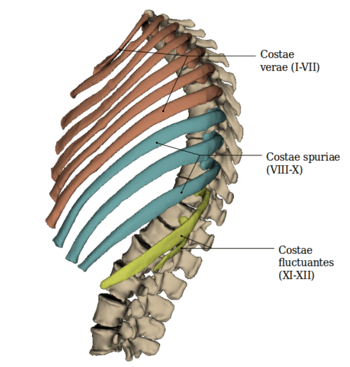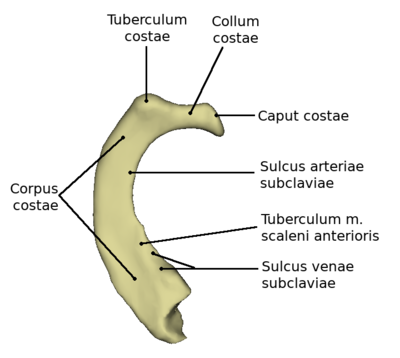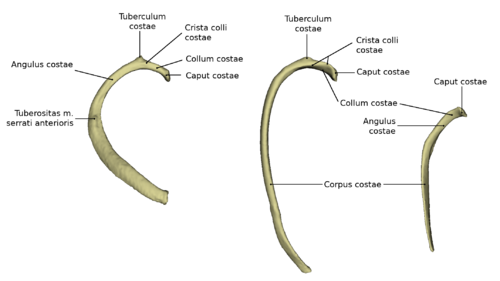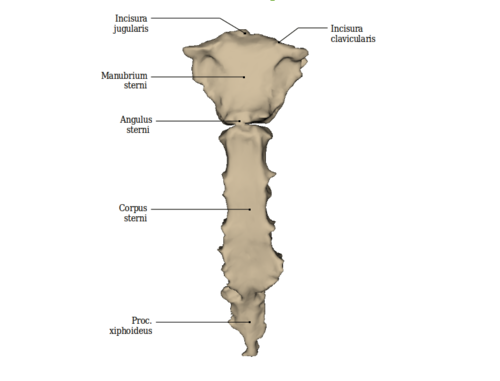Rippen und Brustbein/en: Unterschied zwischen den Versionen
Becher (Diskussion | Beiträge) (Die Seite wurde neu angelegt: „<div class="clear"></div> Each pair of ribs is bilaterally symmetrical, but the shape is different in each segment. The rib neck ranges from the rib head (<i>C…“) |
Becher (Diskussion | Beiträge) (Die Seite wurde neu angelegt: „back to the trunk wall“) |
||
| (10 dazwischenliegende Versionen desselben Benutzers werden nicht angezeigt) | |||
| Zeile 47: | Zeile 47: | ||
The rib neck ranges from the rib head (<i>Caput costae</i>) to the rib hump (<i>Tuberculum costae</i>) and is located at the dorsal end of the rib. With the exception of the 1st rib, it has an upwardly directed groin (<i>Crista colli costa</i>). | The rib neck ranges from the rib head (<i>Caput costae</i>) to the rib hump (<i>Tuberculum costae</i>) and is located at the dorsal end of the rib. With the exception of the 1st rib, it has an upwardly directed groin (<i>Crista colli costa</i>). | ||
| − | + | The rib body (<i>Corpus costae</i>) bends to the front laterally from the rib cusp, forming the rib angle (<i>Angulus costae</i>). The rib bodies of the 2nd-11th rib show irregular curvatures, the so-called surface and edge curvatures. | |
| − | + | Due to their additional rotation about the longitudinal axis, the outer surfaces of the ribs are slightly caudal at their vertebral end and slightly cranial at their ventral end. Normally the 1st and 12th ribs are shortest and the 7th rib is longest. The rib cartilage in turn increases in length from the 1st to the 7th rib and becomes shorter again from the 8th rib. With the exception of the 1st, 11th and 12th ribs, each rib has a groove (<i>Sulcus costae</i>) on its underside in which the intercostal vessels and nerves are relatively protected. | |
| − | == | + | ==Sternum== |
| − | + | The sternum is a flat, sword-shaped and slightly forward arched bone. The side of the sternum has several notches (<i>Incisurae costales</i>). | |
| − | + | Ventral and lateral view of the sternum: | |
| − | [[File:Sternum.png|left|500px| | + | [[File:Sternum.png|left|500px|Ventral view of the sternum]] |
| − | [[File:SternumLateral.png|right|480px| | + | [[File:SternumLateral.png|right|480px|Lateral view of the sternum]] |
<div class="clear"></div> | <div class="clear"></div> | ||
| − | + | The sternum can be divided into three main bony sections: Manubrium (<i>Manubrium sterni</i>), body (<i>Corpus sterni</i>), and sword process (<i>Processus xiphoideus</i>). | |
| − | + | Good palpation through the skin is a notch (<i>Incisura jugularis</i>) at the cranial margin of the manubrium. | |
| − | + | The depressions <i>Incisurae claviculares</i> (right and left) allow the connection to the respective clavicle. | |
| − | + | The flat notch (<i>Incisura costalis I</i>) below is for the cartilaginous connection with the first rib. | |
| − | + | The other notches (<i>Incisura II-VII</i>) are for the cartilaginous connection with ribs 2-7. | |
| − | + | At <i>Angulus sterni</i> the manubrium is slightly bent backwards against the body of the sternum. | |
| − | + | The sword process is often cartilaginous and has no connection to a rib. | |
<br> | <br> | ||
<div style="text-align: center"> | <div style="text-align: center"> | ||
| − | <b> | + | <b> The bony structure of the thorax for free exploration</b><br> |
<segmenter border="1">https://dornheim.cloud/index.php/apps/segmenter/embedding/view?identifier=b7GTgSO6dYaQ</segmenter> | <segmenter border="1">https://dornheim.cloud/index.php/apps/segmenter/embedding/view?identifier=b7GTgSO6dYaQ</segmenter> | ||
| Zeile 82: | Zeile 82: | ||
---- | ---- | ||
<br> | <br> | ||
| − | '' | + | ''Further links'' |
| − | '''[[Special:MyLanguage/Übungsaufgaben| | + | '''[[Special:MyLanguage/Übungsaufgaben|Exercises]]''' |
| − | [[Special:MyLanguage/Rumpfwand| | + | [[Special:MyLanguage/Rumpfwand|back to the trunk wall]] |
Aktuelle Version vom 2. Januar 2020, 14:19 Uhr
Inhaltsverzeichnis
Ribs
Ribs are paired, curved, rod-shaped bones that originate on the dorsal side of the thoracic spine.
Most ribs then reach the sternum in a semicircle.
In this way they create a cross connection between the two structures and thus serve the stability and elasticity of the thorax.
Usually the female thorax is narrower and shorter than the male.
A human has a total of twelve pairs of ribs, which corresponds to the number of thoracic vertebrae.
Each rib consists of the actual rib bone (Os costale) and an adjacent cartilage section, the rib cartilage (Cartilago costalis). The individual ribs do not border directly on each other, but are separated from each other by the intercostal space.
This space is partly filled by the intercostal muscles.
The rib heads connect the ribs to the spine in an articulated manner. Each rib touches two consecutive vertebrae. The articular surface of the rib head (Facies articularis capitis costae) is therefore divided into two parts.
The rib hump (Tuberculum costae) is located at the rib neck and is connected to the transverse process of the thoracic vertebra at the same level by a small articular surface (Facies articularis tuberculi costae). Not far from the rib neck is the Angulus costae (rib angle). The flat rib body has a convex outer surface (Facies externa) and a concave inner surface (Facies interna). The anterior part of the ribs consists of cartilage. This connects the ribs elastically to the sternum. Without this freedom of movement, the ribs would not be able to move with inhalation and expiration.
Classification of the ribs
The ribs can be divided into three groups. The connection to the sternum is decisive for this.
The first seven pairs of ribs reach the sternum directly as so-called real ribs (Costae verae).
The next five ribs are called false rib pairs (Costae spuriae). The 8th, 9th and 10th ribs are only indirectly connected to the sternum. The closest rib cartilages connect and are thus involved in the development of the costal arch (Arcus costalis).
The last two "false" rib pairs (Costae fluctuantes) of the 11th and 12th rib usually end freely between the muscles of the lateral abdominal wall.
Different rib shapes
Each pair of ribs is bilaterally symmetrical, but the shape is different in each segment. The rib neck ranges from the rib head (Caput costae) to the rib hump (Tuberculum costae) and is located at the dorsal end of the rib. With the exception of the 1st rib, it has an upwardly directed groin (Crista colli costa).
The rib body (Corpus costae) bends to the front laterally from the rib cusp, forming the rib angle (Angulus costae). The rib bodies of the 2nd-11th rib show irregular curvatures, the so-called surface and edge curvatures.
Due to their additional rotation about the longitudinal axis, the outer surfaces of the ribs are slightly caudal at their vertebral end and slightly cranial at their ventral end. Normally the 1st and 12th ribs are shortest and the 7th rib is longest. The rib cartilage in turn increases in length from the 1st to the 7th rib and becomes shorter again from the 8th rib. With the exception of the 1st, 11th and 12th ribs, each rib has a groove (Sulcus costae) on its underside in which the intercostal vessels and nerves are relatively protected.
Sternum
The sternum is a flat, sword-shaped and slightly forward arched bone. The side of the sternum has several notches (Incisurae costales). Ventral and lateral view of the sternum:
The sternum can be divided into three main bony sections: Manubrium (Manubrium sterni), body (Corpus sterni), and sword process (Processus xiphoideus).
Good palpation through the skin is a notch (Incisura jugularis) at the cranial margin of the manubrium. The depressions Incisurae claviculares (right and left) allow the connection to the respective clavicle. The flat notch (Incisura costalis I) below is for the cartilaginous connection with the first rib. The other notches (Incisura II-VII) are for the cartilaginous connection with ribs 2-7. At Angulus sterni the manubrium is slightly bent backwards against the body of the sternum. The sword process is often cartilaginous and has no connection to a rib.
The bony structure of the thorax for free exploration
<segmenter border="1">https://dornheim.cloud/index.php/apps/segmenter/embedding/view?identifier=b7GTgSO6dYaQ</segmenter>
Further links





